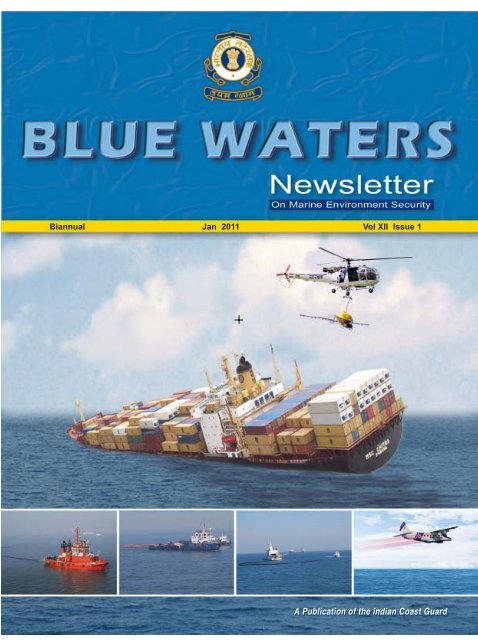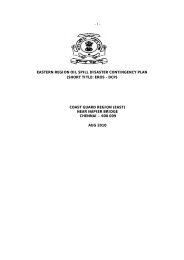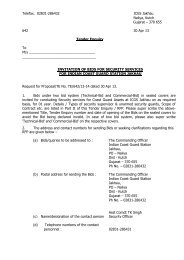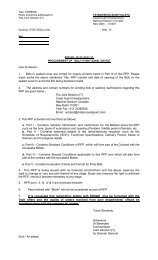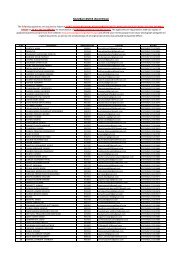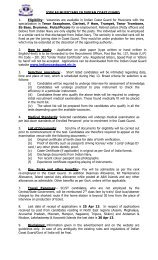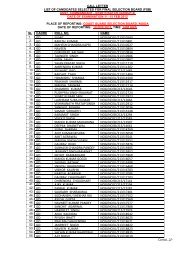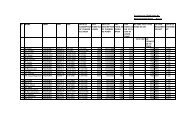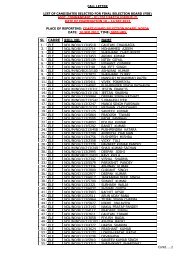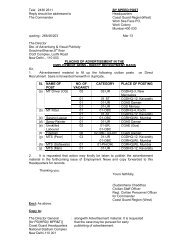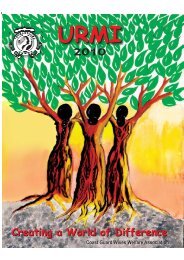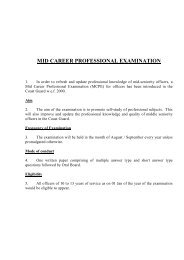Jan 2011 edition - Indian Coast Guard
Jan 2011 edition - Indian Coast Guard
Jan 2011 edition - Indian Coast Guard
Create successful ePaper yourself
Turn your PDF publications into a flip-book with our unique Google optimized e-Paper software.
Biannual <strong>Jan</strong> <strong>2011</strong> Vol XII Issue 1<br />
A Publication of the <strong>Indian</strong> <strong>Coast</strong> <strong>Guard</strong>
From the Director General’s Desk<br />
A very happy new year to all.<br />
The collision between MSC Chitra and MV Khalija off Mumbai in Aug 2010, and the consequent<br />
oil spill is a grim reminder of the increasing risks of oil pollution in the vicinity of our ports. Though<br />
the <strong>Coast</strong> <strong>Guard</strong> played a major role in mitigating the pollution damage, some part of the oil eventually<br />
reached the shoreline due to strong tidal actions aided by the south-west monsoon.<br />
The Government of Maharashtra was also challenged by the deleterious effects of the oil spill.<br />
The <strong>Indian</strong> <strong>Coast</strong> <strong>Guard</strong> has sensitized all <strong>Coast</strong>al State Governments to prepare Local Oil Spill<br />
Contingency Plans for effective oil spill response, as this is a difficult task which cannot be undertaken<br />
by any single agency. There is an immediate requirement for all concerned Ports and <strong>Coast</strong>al State<br />
Governments to prepare themselves adequately taking due cognizance of the detrimental effects of<br />
an oil spill. Further, the regulatory authorities, such as DG Shipping, need to analyse the incidents<br />
of ship collisions, and institute preventive measures to avoid the consequent oil spill.<br />
The <strong>Coast</strong> <strong>Guard</strong>’s oil spill response capability has been strengthened by the commissioning<br />
of the first indigenously built Pollution Control Vessel in October 2010. The utility of the Pollution<br />
Control Vessel during the oil spills, will certainly enhance the oil spill response considerably.<br />
The Chitra incident prompted the <strong>Indian</strong> <strong>Coast</strong> <strong>Guard</strong> to analyse the existing inventory of<br />
equipment, and identify suitable pollution response equipment to be operated through vessels of<br />
opportunity. A working group has been constituted to recommend a suitable response system. The<br />
group would recommend the road map for the future oil spill response in India. In addition, a seminar<br />
on oil spill response with participation of international speakers is also planned in Jul <strong>2011</strong> at New<br />
Delhi, to obtain information on recent developments in oil spill response all across the globe.<br />
I request all the stakeholders and other interested organisations to participate in this seminar and<br />
gain from it.<br />
Jai Hind<br />
31 <strong>Jan</strong> 11<br />
New Delhi<br />
(Anil Chopra)<br />
Vice Admiral<br />
Director General<br />
<strong>Indian</strong> <strong>Coast</strong> <strong>Guard</strong>
<strong>Jan</strong> <strong>2011</strong> Vol XII Issue 1<br />
Editorial<br />
This <strong>edition</strong> of ‘Blue Waters’ focuses on ‘Oil<br />
Spill incident of MV MSC Chitra’, which occurred<br />
at Mumbai Port on 07 Aug 2010. The oil spill<br />
though estimated to be around 800 tons caused<br />
damage to the sensitive coast lines, in spite of<br />
spirited efforts put up by <strong>Coast</strong> <strong>Guard</strong>, Govt. of<br />
Maharashtra, MbPT, <strong>Indian</strong> Navy, Salvage<br />
Company, Pollution Control Boards, NGOs and<br />
the volunteers. The strong tidal currents aided<br />
by South West monsoon, and the floating<br />
containers inside the channel posed several<br />
challenges, making the response agencies to<br />
adopt several contingency measures and learn<br />
valuable lessons from the incident. The<br />
concerned ministries have already initiated<br />
several measures so that the oil spill<br />
emergencies are addressed effectively in all<br />
weather conditions and challenging situations.<br />
The second part of the Oil Spill response<br />
operation undertaken by the response agencies<br />
for Deep Water Horizon oil spill at Gulf of Mexico<br />
is also included in this <strong>edition</strong>, so as to provide<br />
the complete account of the efforts made for<br />
the clean-up. The primary oil spill prevention<br />
measure as identified by the <strong>Coast</strong> <strong>Guard</strong> is the<br />
removal of source of oil spill from the ships that<br />
have met with casualty. The <strong>Coast</strong> <strong>Guard</strong> has<br />
accordingly directed the shipowners to remove<br />
the trapped oil from sunken ships. The trapped<br />
oil from most of the ships such as MV Asian<br />
Forest, MV Den Den, MV Black Rose, MV Chitra<br />
that have met with casualty, are removed by the<br />
salvors and the efforts are being made by the<br />
concerned ministry to have such salvage<br />
capacity in India through a service provider. A<br />
brief account of removal process undertaken for<br />
MV Black Rose is included in this <strong>edition</strong> for<br />
information of the readers.<br />
ARTICLES<br />
MSC Chitra Incident 3<br />
Salvage Operations for Removal of 5<br />
Trapped Oil from Ships<br />
An Update on the Gulf of Mexico Oil Spill 7<br />
REPORTS<br />
India Watch<br />
Oil Spill by MV MSC Chitra 10<br />
Collision between MV Tiger Spring 10<br />
and Green Valley<br />
Defueling of 10<br />
MV Nand Aparajita<br />
World Watch<br />
Hurghada, Egypt 11<br />
Montreal, Canada 11<br />
Rosario, Philippines 11<br />
IMO NEWS<br />
Sixty First Session of IMO Marine 12<br />
Environment Protection Committee (MEPC)<br />
EVENTS<br />
Third National Level Pollution 13<br />
Response Exercise (NATPOLREX-III)<br />
Information on proposed <strong>Coast</strong> <strong>Guard</strong> 14<br />
Seminar on Oil Spill Response<br />
INFORMATIONS<br />
CONTENTS<br />
<strong>Indian</strong> <strong>Coast</strong> <strong>Guard</strong> Annual Pollution 15<br />
Response Training Programme - <strong>2011</strong><br />
(Donny Michael)<br />
Commandant<br />
Director (F&E)<br />
Minor and Major Oil Spills 17<br />
in <strong>Indian</strong> waters (since 1982)
ARTICLES<br />
<strong>Jan</strong> <strong>2011</strong> Vol XII Issue 1<br />
MSC CHITRA INCIDENT<br />
On 07 August 2010, at 0950 hrs, the container<br />
vessel MV MSC Chitra carrying about 1200 containers<br />
from JN Port while leaving harbour, collided with an<br />
inbound bulk carrier MV Khalija-III, leading to grounding<br />
of MV Chitra near the Prongs reef light. The impact of<br />
the collision caused rupture of two fuel tanks situated<br />
on the port side of MV Chitra. The ships crew were<br />
safely evacuated and the vessel started to list<br />
dangerously to the port side. The rupture of the tanks<br />
led to oil spill at a steady rate of 20 tons per hour. As<br />
the South West monsoon was active, the prevailing<br />
strong winds and sea state prevented the laying of<br />
containment booms by the <strong>Coast</strong> <strong>Guard</strong>. The port was<br />
affected by the high tides which ranged upto 4 meters.<br />
The major ports did not take any preventive action to<br />
contain the oil spill as they did not have any oil spill<br />
response equipment. The situation got worsened when<br />
the tide changed after two hours from the collision, the<br />
continuous impact of the waves caused more list to the<br />
grounded vessel and about 300 containers fell<br />
overboard making it dangerous for navigation. <strong>Indian</strong><br />
<strong>Coast</strong> <strong>Guard</strong> deployed 5 ships, 2 helicopters and<br />
2 Dorniers in pollution response configuration and<br />
applied oil spill dispersants to mitigate the damage<br />
caused by the effects of the heavy oil. The tidal currents<br />
in combination with the local currents carried the spilt<br />
oil in the south and other coastal areas affecting the<br />
fisher folks seriously. The port’s traffic was closed due<br />
to floating containers, several ships and tankers waiting<br />
outside for entry were forced to the outer anchorage<br />
area. In addition, it was found that 43 containers were<br />
packed with IMDG cargoes and some of it fell overboard<br />
and washed ashore.<br />
<strong>Coast</strong> <strong>Guard</strong> ships and aircraft relentlessly carried<br />
out the oil spill response in-spite of the dangerous<br />
containers floating inside the harbour. As the leaking<br />
spot of the tanks could not be reached by the salvage<br />
team, and at the same time, it could not be transferred<br />
to other tanks, the <strong>Coast</strong> <strong>Guard</strong> took a conscious<br />
decision to allow the oil to drain from the two ruptured<br />
tanks. The oil egress from the tanks stopped after<br />
48 hours. By then, 60 kilometers of the shoreline area,<br />
including the residential, fisheries, mangroves, ports and<br />
historic islands were affected by the heavy fuel oil. The<br />
remaining oil at sea was neutralized by the <strong>Coast</strong> <strong>Guard</strong><br />
in the next 3 days. It was found that the majority of the<br />
oil that washed ashore did not emulsify due to the effect<br />
of the dispersants applied by the <strong>Coast</strong> <strong>Guard</strong>. In the<br />
following two months, a dedicated shoreline response<br />
team including a special team from Oil Spill Response<br />
Limited, Singapore undertook shoreline clean-up of the<br />
affected areas. In some areas, the clean-up went on<br />
upto four months. The port traffic was effectively closed<br />
for five days, and only limited movements with a mine<br />
sweeper escort was allowed. The restriction of the ship<br />
movements, severely affected the logistics chain<br />
supporting the shipping movements. The harbour<br />
was closed for fishing for about a month, thereby<br />
affected the fishermen and fish related traders due to<br />
unemployment. The <strong>Coast</strong>al State Government, Mumbai<br />
Port, <strong>Coast</strong> <strong>Guard</strong> and other affected parties have<br />
submitted claims for clean –up and for causing pollution<br />
3
<strong>Jan</strong> <strong>2011</strong> Vol XII Issue 1<br />
damage on the shipowner. The shipowner, employed<br />
professional salvors immediately and all out efforts<br />
were made to remove all the containers drifting and<br />
sunken containers. By end August 10, almost<br />
all the sunken containers were identified and<br />
removed. The remaining containers onboard were<br />
safely removed by November 10. The trapped oil of<br />
about 1200 tonnes of fuel oil was removed by the<br />
salvors, and the efforts are being made to remove the<br />
wreck by end March <strong>2011</strong>.<br />
Lessons Learnt<br />
Several lessons were learnt from the MV Chitra oil<br />
spill incident. The pollution response equipment<br />
available with the <strong>Coast</strong> <strong>Guard</strong> were not compatible to<br />
contain the oil spill in the fast tidal current. The shoreline<br />
terrain was mostly rocky and the inshore boom laying<br />
was not found useful. For effective protection of<br />
mangroves, there is a need for deflection booms. The<br />
vessels deployed for the response require modification<br />
to carry pollution response equipment for skimming<br />
operations. There is no private oil spill response provider<br />
available to undertake oil spill response on behalf of<br />
the polluting ship or on behalf of the port. The local<br />
State Government is ill prepared to prevent the spill<br />
reaching their shorelines and also to undertake the<br />
shoreline clean-up. The contingency plan prepared by<br />
the ports and oil handling agencies do not cater for<br />
complete response for more than 100 tons. Hence,<br />
proposals were made to augment the pollution<br />
response capacity to the ports by the Ministry through<br />
the Oil Cess Fund.<br />
Post MSC Chitra Measures<br />
The <strong>Coast</strong> <strong>Guard</strong> being the Central Coordinating<br />
Authority (CCA) for oil spill response, is reviewing its<br />
national plans and also recommended the Shipping<br />
ministry to direct all the ports to mandatorily maintain<br />
oil spill response facility either by them or through the<br />
service providers. A separate Committee has been<br />
appointed to undertake the efficiency test of all pollution<br />
response equipment available with the <strong>Coast</strong> <strong>Guard</strong><br />
inventory and also to recommend the necessary<br />
legislative measures to make the polluting ship<br />
undertake the clean-up immediately and also to pay<br />
immediate compensation to the affected parties. The<br />
<strong>Coast</strong> <strong>Guard</strong>’s oil spill response capability has been<br />
strengthened by the commissioning of the first<br />
indigenously built Pollution Control Vessel having side<br />
sweeping arms with skimming capability of 110 tons<br />
per hour each. If this ship was available during the<br />
MV Chitra oil spill, it would have been effectively<br />
positioned near the leaking area and would have<br />
skimmed the oil easily. The <strong>Coast</strong> <strong>Guard</strong> environment<br />
protection directorate is coordinating with all the<br />
stakeholders to put in place an effective pollution<br />
response system in India. Post MV Chitra oil spill<br />
incident, there is an increased awareness among the<br />
media and the local populace about the negative effects<br />
of oil spill on the marine environment. The public looks<br />
4
<strong>Jan</strong> <strong>2011</strong> Vol XII Issue 1<br />
upon <strong>Coast</strong> <strong>Guard</strong> to provide necessary solution and<br />
the organisation is taking all measures that is necessary<br />
to meet all the expectations and also to ensure that the<br />
marine environment is always protected.<br />
SALVAGE OPERATIONS<br />
FOR REMOVAL OF TRAPPED OIL<br />
FROM SHIPS<br />
Prevention of pollution and protection of Marine<br />
Environment has been the primary charter of the duties<br />
of <strong>Coast</strong> <strong>Guard</strong> and all necessary measures in<br />
accordance to the powers provided to the <strong>Coast</strong> <strong>Guard</strong><br />
are taken promptly and assistance where required has<br />
been provided to other agencies on various occasions.<br />
Under the allocation of Business Rules 1962, and<br />
also under the procedure established in the National<br />
Oil Spill Disaster Contingency Plan (NOSDCP), the<br />
responsibility of responding to oil pollution at port<br />
premises rests with the concerned port and the port<br />
can claim the clean-up cost from the polluting<br />
shipowner/insurer. All ships above 500 tons and<br />
operating internationally are required to take<br />
compulsory insurance for Hull, Machinery and third<br />
party liability.<br />
In the case of ship sinking, generally oil spill takes<br />
place due to the presence of bilges in the engine room<br />
and other oils kept for ready use and not sealed in any<br />
tanks or containers. For a ship that runs aground, the<br />
oil spills may take place if the hull is breached and the<br />
oil escapes from the breached tank/tanks. Such oil spills<br />
which occur immediately after the casualty can be<br />
responded effectively after taking necessary<br />
assessment, planning, operations and clean-up<br />
coordination. However, the oil carried onboard the ship<br />
in the form of cargo or bunkers may still remain in their<br />
tanks intact even after sinking or grounding. For<br />
example, in the case of MV MSC Chitra, the ship carried<br />
2600 tons of fuel oil out of which 800 tons of fuel oil<br />
escaped from her two tanks due to the hole created<br />
during the collision with MV Khalija on 07 Aug 2010.<br />
Earlier, the shipowners did not take any action to<br />
remove the trapped oil from the ship tanks. The <strong>Coast</strong><br />
<strong>Guard</strong> nor any agency in India has the necessary<br />
expertise and the equipment to remove oil from a sunken<br />
ship. The trapped oil may come out of the tanks at any<br />
time without warning and may cause serious economic<br />
and ecological damage to the local marine environment.<br />
However, since the year 2006, the <strong>Coast</strong> <strong>Guard</strong> has<br />
taken proactive measures in making the shipowners<br />
responsible for removing the trapped oil from the<br />
casualty ridden ship. The first such case was the<br />
removal of oil from MV Ocean Seraya, which ran<br />
aground at Karwar and 900 tonnes of fuel oil was<br />
removed. In 2007, 350 tonnes of trapped fuel oil from<br />
sunken ship MV Denden was removed by salvors off<br />
Mangalore. In 2009, 330 tonnes of fuel oil was removed<br />
from MV Asian Forest off Mangalore and 930 tonnes<br />
of fuel oil from MV Black Rose off Paradip. In 2010,<br />
20 tonnes of diesel was removed from MV Nand Aparita<br />
off Kavaratti and 1200 tonnes from MV MSC Chitra off<br />
Mumbai. The IMO wreck Removal Convention (Nairobi<br />
convention) has mandatory provisions for removing<br />
oil from the sunken ships by the shipowners besides<br />
the liability to remove the wreck that may happen in<br />
coastal waters.<br />
Case study on Oil Removal Process from<br />
sunken ship - MV Black Rose<br />
5
<strong>Jan</strong> <strong>2011</strong> Vol XII Issue 1<br />
The merchant vessel MV Black Rose sank<br />
4 km outside the Paradip Port but inside the Port limits.<br />
Following the incident of sinking of the ship near the<br />
Paradip Port, the oil spill from bilges came out and there<br />
were reports of traces of dead fish and other marine<br />
life along the coast. The <strong>Coast</strong> <strong>Guard</strong> and the Paradip<br />
Port Trust responded to all minor traces of the oil sheen<br />
found outside the ship and it was feared that the ships<br />
can’t be permanently positioned to respond to minor<br />
traces of oil every time as the ship still held 930 tonnes<br />
of fuel oil. The Ministry of Environment and Forests had<br />
expressed concern that in case the stored oil in the<br />
vessel is not evacuated at the earliest it could pose<br />
serious danger to the environment and marine species<br />
in the region.<br />
The tender was awarded to Resolve Marine<br />
Groups, Florida. The agency assured to complete the<br />
operation in 45 days at the cost of Rs 17.50 crores.<br />
Seven members of the agency visited the spot<br />
initially and surveyed the oil stock in the vessel. They<br />
said that the 975 tonnes of oil has been kept in<br />
three sealed chambers of the vessel and are in<br />
semi-solid form. The oil would be pumped out after<br />
heating the chambers. The hot-tapping equipment<br />
and other related materials were then brought to<br />
Paradip and the salvors commenced their work on<br />
10 Oct 10. During this period the sea was calm<br />
which assisted the salvors to proceed with their work<br />
at greater pace.<br />
engineering challenge for salvors and increases the<br />
overall cost of the salvage effort for vessel owners.<br />
Advances in diving technology, the use of remotely<br />
operated devices, specially fitted emergency tank<br />
access ports on vessels and improvements in hottapping<br />
technology have all made liquid retrieval a more<br />
common practice in salvage.<br />
The most widely employed technique for removing<br />
pollutants from the tanks of sunken vessels is hot<br />
tapping.<br />
In the hot-tapping method, the naval architect of the<br />
salvage company working from the blueprints of the<br />
vessel, advise the divers to mark the tanks and the<br />
tapping locations. At each location, a 5/8-inch hole was<br />
drilled through the hull plating into the tank by a diver<br />
using a hydraulic drill. The hole was also threaded using<br />
the same tool. After removing the tool, the diver after<br />
determining the nature of the contents of the tank —<br />
whether oil or water — reseals the hole with a bolt.<br />
Once the tanks containing the pollutants had been<br />
identified, a landing plate with a valve and a cam lock<br />
hose fitting is then installed on the tank. A hot-tap<br />
device is thereafter fitted to the cam lock fitting on the<br />
landing plate.<br />
The hot-tap device is designed to drill through the<br />
plating without allowing the tank’s contents to<br />
escape.<br />
Before salvage operations can begin, salvage<br />
company is required to recover any potentially polluting<br />
liquids first from a sunken vessel. Even in case where<br />
it is decided not to raise a vessel, as in this case, often<br />
it is still deemed necessary to remove any liquids that<br />
might be harmful, if they were to escape into the<br />
environment.<br />
Removing these liquids represent a daunting<br />
6
<strong>Jan</strong> <strong>2011</strong> Vol XII Issue 1<br />
The Oil removal work from sunken Mongolian<br />
vessel MV Black Rose began in October 09, after<br />
Customs gave clearance to Paradip Port Trust (PPT)<br />
authorities to transport the pumped out oil through<br />
lorries and was completed in Nov 09, thereby<br />
removing the threat of oil spill from the sunken ship<br />
MV Black Rose.<br />
The wreck of MV black rose still remain in the area<br />
and a wreck marking has been done by the port. Post<br />
this incident, the DG Shipping has issued M.S. Notice<br />
No. 31 and 34 of 2009 on safe loading of Iron ores<br />
from <strong>Indian</strong> ports. It has also issued notice to all<br />
Principal Officers of MMD to ensure 100 % inspection<br />
of all ships arriving in <strong>Indian</strong> ports to load Iron ores.<br />
AN UPDATE ON THE GULF OF<br />
MEXICO OIL SPILL<br />
PART - II<br />
(Continued from previous <strong>edition</strong> of Blue Waters)<br />
(Source - Internet Resources)<br />
The Deepwater Horizon oil spill or Gulf of Mexico<br />
oil spill or popularly known as the BP oil disaster is<br />
an oil spill which flowed for three months in 2010<br />
commencing 20 Apr 2010. The impact of the spill still<br />
continues even after the well was capped. It is the<br />
largest accidental marine oil spill in the history of the<br />
petroleum industry. The spill stemmed from a sea-floor<br />
oil gusher that resulted from the April 20, 2010<br />
Deepwater Horizon oil rig explosion. The explosion killed<br />
11 men working on the platform and injured 17 others.<br />
On July 15, the leak was stopped by capping the<br />
gushing wellhead, after it had released about<br />
4.9 million barrels, or about tons of crude oil. It was<br />
estimated that 53,000 barrels per day (8,400 m 3 /d) were<br />
escaping from the well just before it was capped. It is<br />
believed that the daily flow rate diminished over time,<br />
starting at about 62,000 barrels per day (9,900 m 3 /d)<br />
and decreasing as the reservoir of hydrocarbons feeding<br />
the gusher was gradually depleted. On September 19,<br />
the relief well process was successfully completed and<br />
the federal government declared the well “effectively<br />
dead”.<br />
The reports reflects that the spill continues to cause<br />
damage to marine and wildlife habitats as well as the<br />
Gulf’s fishing and tourism industries. In late November<br />
2010, 4,200 square miles (11,000 km 2 ) of the Gulf were<br />
re-closed to shrimping after tar balls were found in<br />
shrimpers’ nets. The total amount of Louisiana shoreline<br />
impacted by oil grew from 287 in July to 320 miles (510<br />
km) in late November. In <strong>Jan</strong>uary <strong>2011</strong>, eight months<br />
after the explosion, an oil spill commissioner reported<br />
that tar balls continue to wash up, oil sheen trails are<br />
seen in the wake of fishing boats, wetlands marsh grass<br />
remains fouled and dying, and that crude oil lies offshore<br />
in deep water and in fine silts and sands onshore.<br />
7
<strong>Jan</strong> <strong>2011</strong> Vol XII Issue 1<br />
Skimmer ships, floating containment booms,<br />
anchored barriers, sand-filled barricades along<br />
shorelines, and dispersants were used in an attempt to<br />
protect hundreds of miles of beaches, wetlands and<br />
estuaries from the spreading oil. Scientists have also<br />
reported immense underwater plumes of dissolved oil<br />
not visible at the surface as well as an 80-square-mile<br />
(210 km 2 ) “kill zone” surrounding the blown BP well.<br />
The U.S. Government has named BP as the responsible<br />
party, and officials have committed to holding the<br />
company accountable for all cleanup costs and other<br />
damage. After its own internal probe, BP admitted that<br />
it made mistakes which led to the Gulf of Mexico oil spill.<br />
Use of Dispersants deep Under Water<br />
Some 1,100,000 US gallons (4,200,000 l) of<br />
chemical dispersants were sprayed at the wellhead five<br />
thousand feet under the sea. This had never previously<br />
been tried but due to the unprecedented nature of this<br />
spill, BP along with the U.S. <strong>Coast</strong> <strong>Guard</strong> and the<br />
Environmental Protection Agency, decided to use “the<br />
first subsea injection of dispersant directly into oil at<br />
the source”.<br />
Dispersants are said to facilitate the digestion of<br />
the oil by microbes. Mixing the dispersants with the oil<br />
at the wellhead would keep some oil below the surface<br />
and in theory, allow microbes to digest the oil before it<br />
OVERVIEW<br />
BP intends to drill two wells<br />
designed to intersect the<br />
original wellborne above<br />
the oil reservoir. This will<br />
allow heavy fluid to be<br />
pumped into the well which<br />
will stop the flow of oil from<br />
the reservoir. Cement will<br />
then be pumped down to<br />
permanently seal the well.<br />
RELIEF WELL #2<br />
Development Driller II<br />
DISCOVERER ENTERPRISE DRILL SHIP<br />
Original MC 252 # 1 Subsea Containment RELIEF WELL # 1<br />
Development Driller III<br />
Spedded May 2nd at 15:27 hrs<br />
CURRENT PROGRESS<br />
Relief Well #1 Spedded - 15:27 May 2nd<br />
Depth Reached 6,805 - 16:30 May 4th<br />
28î Casing String Set & Cemented in Place<br />
reached the surface. Various risks were identified and<br />
evaluated, in particular that an increase in the microbe<br />
activity might reduce the oxygen in the water. Various<br />
models were run and the effects of the use of the<br />
dispersants was monitored closely. The use of<br />
dispersants at the wellhead was pursued and the<br />
National Oceanic and Atmospheric Administration<br />
(NOAA) estimated that roughly 409,000 barrels of oil<br />
were dispersed underwater.<br />
Environmental scientists say the dispersants, which<br />
can cause genetic mutations and cancer, add to the<br />
toxicity of the spill and that sea turtles and bluefin tuna<br />
are exposed to an even greater risk than crude alone.<br />
According to them, the dangers are even greater for<br />
dispersants poured into the source of the spill, where<br />
they are picked up by the current and wash through the<br />
Gulf . The researchers say the dispersed oil appears to<br />
be having a toxic effect on bacteria and phytoplankton<br />
- the microscopic plants which make up the basis of the<br />
Gulf’s food web. The field-based results were consistent<br />
with shore-based laboratory studies showing that<br />
phytoplankton are more sensitive to chemical<br />
dispersants than the bacteria, which are more sensitive<br />
to oil. On the other hand, the NOAA says that toxicity<br />
tests have suggested that the acute risk of dispersantoil<br />
mixtures is no greater than that of oil alone. However,<br />
some experts believe that all the benefits and costs may<br />
not be known for decades.<br />
Because the dispersants were applied deep under<br />
the sea, much of the oil never rose to the surface -<br />
which means it went somewhere else, reported a<br />
marine scientist . One plume of dipersed oil has been<br />
that measured at 22 miles (35 km) long, more than a<br />
mile wide and 650 feet (200 m) tall. In a major study on<br />
the plume, experts found the most worrisome part to<br />
be the slow pace at which the oil is breaking down in<br />
the cold, 40 °F (4 °C) water at depths of 3,000 feet<br />
(910 m) ‘making it a long-lasting but unseen threat to<br />
vulnerable marine life’.<br />
8
<strong>Jan</strong> <strong>2011</strong> Vol XII Issue 1<br />
Removal<br />
Three basic approaches to removing the oil from<br />
the water have been burning the oil, filtering off-shore,<br />
and collecting for later processing. On April 28, the US<br />
<strong>Coast</strong> <strong>Guard</strong> announced plans to corral and burn off<br />
up to 1000 barrels of oil each day. It tested how much<br />
environmental damage a small, controlled burn of 100<br />
barrels did to surrounding wetlands, but could not<br />
proceed with an open ocean burn due to poor<br />
conditions.<br />
BP stated that more than 215,000 barrels of oilwater<br />
mix had been recovered by May 25. In mid June,<br />
BP ordered 32 machines that separate oil and water<br />
with each machine capable of extracting up to 2000<br />
barrels per day. By June 28, BP had successfully<br />
removed 890,000 barrels of oily liquid and burned about<br />
314,000 barrels of oil.<br />
More recently the EPA reported that there were<br />
successful attempts made to contain the environmental<br />
impact of the oil spill, in which the Unified Command<br />
used the “situ burning” method to burn off the oil in<br />
controlled environments on the surface of the ocean<br />
to try and limit the environmental damages on the<br />
ocean as well as the shorelines. 411 controlled burn<br />
events took place, of which 410 could be quantified.<br />
The Environmental Protection Agency prohibited the<br />
use of skimmers that left more than 15 parts per million<br />
of oil in the water. Many large-scale skimmers were<br />
therefore unable to be used in the cleanup because<br />
they exceed this limit. An urban myth developed that<br />
the U.S. government declined the offers because of the<br />
requirements of the Jones Act. This proved untrue and<br />
many foreign assets deployed to aid in cleanup efforts.<br />
The Taiwanese supertanker A Whale, recently retrofitted<br />
as a skimmer, was tested in early July but failed to collect<br />
a significant amount of oil.<br />
According to a senior scientist at NOAA’s Office of<br />
Response and Restoration, who defended a report<br />
written by the National Incident Command (NIC) on the<br />
fate of the oil stated that using an Oil Budget Calculator<br />
(OBC) developed for this spill, 6% was burned and 4%<br />
was skimmed and much of the oil has evaporated or<br />
been dispersed or dissolved into the water column, and<br />
about 800,000 barrels were siphoned off directly from<br />
the well. NOAA has been criticized by some independent<br />
scientists and Congress for the report’s conclusions and<br />
for failing to explain how the scientists arrived at the<br />
calculations.<br />
More debates on the use of dispersants under water<br />
and the long term effects in the Gulf of Mexico are being<br />
discussed in many environmental forums and will likely<br />
to continue. The Deepwater Horizon oil spill response<br />
ranks one of the largest ever response made in the<br />
annals of history and the lessons it provided will pave<br />
way for many countries to take suitable preventive<br />
measures and avoid the recurrence of another<br />
Deepwater Horizon type incident.<br />
9
REPORTS<br />
<strong>Jan</strong> <strong>2011</strong> Vol XII Issue 1<br />
INDIA WATCH<br />
OIL SPILL BY MV MSC CHITRA<br />
On 07 Aug 10 at about 0925 hrs the Panama<br />
flagged MV MSC Chitra collided with St Kitts registered<br />
MV Khalijia-III about 02 kilometer SE of prongs Lt. near<br />
Mumbai Harbour. Consequent to collision MV MSC<br />
Chitra ran aground and dangerously listed 35-40 degree<br />
to port. As a resulted of the list the containers fell over<br />
board in the channels, leading to a dangerous<br />
navigational situation. The Mumbai port was closed<br />
shortly to clear the dangerous containers and the<br />
commercial vessels were allowed to enter and leave<br />
with naval minesweeper escorts.<br />
On 08 Aug 10 for augmentation for Pollution<br />
Response “Operation Chitra” was launched by <strong>Indian</strong><br />
<strong>Coast</strong> <strong>Guard</strong> vessels. The patches of oil were observed<br />
in various locations in the channels and inlets within<br />
port limit area extending were responded from 08-11<br />
Aug 10 by five <strong>Coast</strong> <strong>Guard</strong> vessels and four Aircraft.<br />
COLLISION BETWEEN MV TIGER<br />
SPRING AND GREEN VALLEY<br />
The Information received by <strong>Coast</strong> <strong>Guard</strong> District<br />
Headquarter regarding collision between MV Tiger<br />
Spring and Green Valley in Hoogly River near Nurpur<br />
Reach on 23 Nov 10. The damage on stbd side tank<br />
no.3 and 4 of MV Tiger Spring resulted in flooding within<br />
the ship causing the vessel list precariously to one side.<br />
At about 1320 hrs, <strong>Coast</strong> <strong>Guard</strong> Dornier was tasked<br />
in Pollution response mode to assess the situation,<br />
Simultaneously, <strong>Coast</strong> <strong>Guard</strong> ACV H-186 along with<br />
damage control equipment was also deployed. Small<br />
patches of oil sheen observed around one NM from<br />
the datum. 50 litres of oil dispersant solution (OSD)<br />
was used to breakdown the oil films by Kolkata<br />
Port Trust.<br />
It was estimated that approximately around<br />
800 tonnes of FFO leaked from MSC Chitra. Other<br />
details on MV MSC Chitra oil spill incident is provided<br />
in the main article.<br />
DEFUELING OF<br />
MV NAND APARAJITA<br />
On 16 Aug 10 MRCC Mumbai received a message<br />
from DG Shipping at 1620 hrs regarding grounding of<br />
MV Nand Aprarjita in position 2 NM West of Kavaratti<br />
island due to rough weather and dragging of anchor.<br />
All crew onboard were safely evacuated. No damage<br />
10
<strong>Jan</strong> <strong>2011</strong> Vol XII Issue 1<br />
to hull has been reported. <strong>Coast</strong> <strong>Guard</strong> Station ICGS<br />
Kavaratti and the local administration directed the ship<br />
owners to remove the fuel oil from the ship prior<br />
undertaking any salvage efforts due to the presence of<br />
coral reefs.<br />
20 kl diesel from MV Nand Aparajita was removed<br />
on 18 Aug with the assistance of <strong>Indian</strong> <strong>Coast</strong> <strong>Guard</strong><br />
and Lakshadweep Harbour Works Department. No oil<br />
spill occurred from the vessel.<br />
WORLD WATCH<br />
The ship spilled about 20 tons of oil and caused<br />
authorities to close the seaway until July 15 when they<br />
allowed traffic to resume at a slow pace.<br />
Because the spill was quickly contained, there was<br />
little damage to the environment, though many large<br />
shipping companies have incurred hefty late fees due<br />
to the closing of the seaway.<br />
ROSARIO, PHILIPPINES<br />
HURGHADA, EGYPT<br />
On 17 June 10, an oil slick was discovered north of<br />
Hurghada, Egypt, in the Red Sea. It has affected about<br />
20 kilometers of coastline, much of it popular tourist<br />
destinations. The leak has been sealed but the oil<br />
has damaged coral reefs and beaches in the area,<br />
threatening two of Hurghada’s most important<br />
industries - tourism and fishing.<br />
The Egyptian government has blamed the spill on<br />
tankers transporting oil through the Red Sea, though<br />
local scientists and activists said it more likely came<br />
from a busted oil rig owned by the government.<br />
MONTREAL, CANADA<br />
On 14 July 10, an underwater Petron pipeline was<br />
damaged, causing a spill two nautical miles off the<br />
coast of the small town of Rosario in Cavite Province,<br />
Philippines. Estimates suggest that about 150 gallons<br />
have spilled and the local authorities have used<br />
both the boom and oil dispersant, to respond to the<br />
oil spill.<br />
The bulk oil carrier MV Richelieu ran aground<br />
in the St.<br />
Lawrence<br />
Seaway on<br />
the south<br />
shore of<br />
Montreal on<br />
the night of<br />
12 July 10.<br />
11
IMO NEWS<br />
<strong>Jan</strong> <strong>2011</strong> Vol XII Issue 1<br />
SIXTY FIRST SESSION OF IMO<br />
MARINE ENVIRONMENT<br />
PROTECTION COMMITTEE (MEPC)<br />
The 61 st MEPC held its 61st session under the<br />
Chairmanship of Mr. Andreas Chrysostomou (Cyprus)<br />
at IMO London from 27 Sep to 01 Oct 2010. The<br />
session was attended by representatives from 101<br />
member States, 1 Associate Member, and 7 United<br />
Nations and Specialized Agencies. It was also attended<br />
by Representatives from 8 Intergovernmental<br />
Organization and 42 Non-Governmental Organizations<br />
in consultative status. The Secretary General opened<br />
with a few words on the drill rig explosion, loss of life<br />
and sinking of the Deepwater Horizon, and the<br />
subsequent oil spill. The Secretary General requested<br />
that the report of the accident be made available to the<br />
organisation, so the IMO may move swiftly to improve<br />
safety in the off shore industry. With regard to oil spill<br />
response for Arctic sea areas in view of the recent<br />
developments in north east passage by ships, the<br />
Secretary General stated that the recovery of oil in<br />
hostile environments will progress as society has a<br />
need for the energy provided by these exploration areas<br />
in the Arctic. He stated that the environmental sensitivity<br />
the Arctic Region requires that the maritime community<br />
give greater focus to these areas and the unique nature<br />
of the environment and the challenges.<br />
The important items that were discussed during<br />
the meeting included following :-<br />
● Invasive species in ballast water and hull fouling,<br />
●<br />
●<br />
●<br />
●<br />
Ship recycling facility guidelines<br />
Reduction of GHG emissions from ships<br />
Implementation of the OPRC Convention, and the<br />
OPRC –HNS Protocol resolutions<br />
Declaration of Straits of Bonifacio as a Particularly<br />
Sensitive Sea Area, (PSSA).<br />
Harmful aquatic organisms in ballast water.<br />
26 states have now ratified the 2005 Ballast Water<br />
Management Convention representing 24.66% of the<br />
world fleet. In order to achieve ratification the IMO<br />
require the following criteria to be met, i.e. 30 states<br />
representing 35% of the world’s DWT. The current<br />
figures fall short of the requirement for ratification, and<br />
the Secretary General urged member states to ratify<br />
the convention<br />
Recycling of ships<br />
The Committee noted that the Hong Kong<br />
International Convention for the Safe and<br />
Environmentally Sound Recycling of Ships, 2009 (the<br />
Hong Kong Convention) had been open for signature<br />
from 1 September 2009 until 31 August 2010. France,<br />
the Netherlands, Italy, Turkey and Saint Kitts and Nevis<br />
had signed the Convention subject to ratification. The<br />
Committee encouraged countries to ratify the<br />
Convention.<br />
The Committee recalled that, since the adoption of<br />
the Hong Kong Convention, MEPC 59 had adopted the<br />
“Guidelines for the development of the Inventory of<br />
Hazardous Materials”. Thereafter, MEPC 60 had agreed<br />
that three further guidelines should be developed in<br />
parallel (on facilities; on the Ship Recycling Plan; and<br />
on the authorization of the facilities) in view of the close<br />
interrelationship between them.<br />
Reduction of GHG Emissions from ships<br />
There were fifty papers submitted on this agenda<br />
item and the report from the inter-sessional expert group<br />
was also presented in plenary on Monday evening. With<br />
regard to Market Based Measures, in general the<br />
plenary was divided along the lines of Kyoto Annex 1<br />
and non Annex 1 parties, and the debate became<br />
increasingly politicised. The main message from Non<br />
Annex one parties is that the UNFCCC should decided<br />
upon market based measures and the IMO should<br />
concentrate on technological and operation abatement<br />
measures abiding by the principles of CBDR. The view<br />
by Annex one countries is that the IMO is the vehicle to<br />
take all measures through to conclusion and those<br />
measures should be flag neutral and offer no more<br />
12
favourable treatment. A great deal of plenary time was<br />
spent on these discussions to the detriment of other<br />
agenda items.<br />
Implementation of the OPRC Convention, and the<br />
OPRC – HNS Protocol and relevant conference<br />
resolutions<br />
<strong>Jan</strong> <strong>2011</strong> Vol XII Issue 1<br />
EVENTS<br />
NATIONAL LEVEL POLLUTION<br />
RESPONSE EXERCISE<br />
(NATPOLREX - III)<br />
The IMO Manual on Oil Pollution, Part 1, Prevention,<br />
amended by OCIMF along with IMarEST received<br />
general support for the document, with comments being<br />
received on chapter 8 oil tanker operations in ice. The<br />
paper MEPC 61 /8/2 Guidance on an Incident<br />
Management System was approved by the Committee<br />
during the meeting.<br />
Paper MEPC 61/8/3 dealt with the Deepwater<br />
Horizon incident. The paper being a summary of the<br />
incident, and concerns were expressed by some local<br />
countries. With assistance from the IMO there were<br />
assessments made on these countries (Bahamas &<br />
Cuba) for technical advisory support, and also the<br />
organisation was requested to determine the type and<br />
quantity of skimmers and booming equipment available.<br />
Paper MEPC 61/8/4 submitted by Sweden, addressed<br />
the issue of the HNS information gap. The Committee<br />
submitted the paper to OPRC-HNS sub-committee for<br />
further necessary action.<br />
Identification of special areas and particularly<br />
sensitive sea areas<br />
The proposal for the Straits of Bonifacio to be<br />
declared a Particularly Sensitive Sea Area (PSSA was<br />
Introduced by France and seconded by Italy, which<br />
consisted of reading of the paper in the plenary. The<br />
States proposing the PSSA stated that all guidelines<br />
are complete and will present them to NAV 57 for<br />
necessary information as required. The Additional<br />
Protection Measures (APM’s) within the paper was<br />
amended to read, “RECOMENDED NON MANDATORY<br />
PILOTAGE” rather than mandatory pilotage.” The<br />
chairman stated that the APM’s should be sent to NAV,<br />
and the IMO should establish a TG at the next meeting,<br />
MEPC 62, to review and then approve at a later date<br />
after IMO have the report from NAV, for approval at a<br />
later meeting of MEPC.<br />
The <strong>Indian</strong> <strong>Coast</strong> <strong>Guard</strong> is the Central Coordinating<br />
Agency (CCA) for responding to all oil spills that occur<br />
in the Maritime Zones of India and therefore has been<br />
mandate to train, coordinate and exercise all<br />
stakeholders. Further, as per section 20 of NOSDCP,<br />
<strong>Coast</strong> <strong>Guard</strong> is entrusted with the responsibility of<br />
conducting regular exercise to assess preparedness<br />
and improve contingency plans of all stakeholders.<br />
Accordingly, third National Level Pollution Response<br />
Exercise (NATPOLREX-III) was conducted off Mumbai<br />
on 15 <strong>Jan</strong> <strong>2011</strong>.<br />
AIM<br />
Aim of the exercise is to evaluate pollution response<br />
capabilities and readiness of all stakeholders, in the<br />
backdrop of oil spill incident from MV MSC Chitra in<br />
Aug 2010. It was also aimed to showcase to other<br />
stakeholders, media and general public, the capabilities<br />
of recently commissioned Pollution Control Vessel<br />
of <strong>Indian</strong> <strong>Coast</strong> <strong>Guard</strong>, ICGS Samudra Prahari. The<br />
exercise was conducted in two phases :-<br />
Phase I<br />
A table top exercise was conducted in the office<br />
13
<strong>Jan</strong> <strong>2011</strong> Vol XII Issue 1<br />
of <strong>Coast</strong> <strong>Guard</strong> Pollution Response Team, Mumbai on<br />
14 <strong>Jan</strong> 11, wherein a simulated situation was exercised<br />
on paper to assess the response of various stakeholders<br />
to the given situation. Following subjects were exercised<br />
during table top exercise:-<br />
(a) Search and Rescue.<br />
(b) Crises Management Group Meeting.<br />
(c) Activation of NOS-DCP.<br />
(d) Oil spill trajectory assessment.<br />
(e) Mitigation measures for resources at risk.<br />
(f) Shoreline protection measures.<br />
(d) Pollution Response operations, that included<br />
application of dispersant, containment and<br />
recovery of spilt oil by ICG ship/aircraft and ships<br />
of other resources agencies.<br />
Participation<br />
Seven ICG ships, two ICG Dornier aircraft, two ICG<br />
Chetak helicopter, one IN ship, two MSVs of ONGC,<br />
one Tug each from MbPT and JNPT and two salvage<br />
vessel from M/s Smit International (India) Ltd<br />
participated in the exercise. Vice Admiral Anil Chopra,<br />
AVSM, the Director General, <strong>Indian</strong> <strong>Coast</strong> <strong>Guard</strong><br />
alongwith 35 personnel from 19 agencies witnessed<br />
the exercise.<br />
Phase II<br />
The phase II of the NATPOLREX-III involved the<br />
realtime exercise of oil spill scenario on 15 <strong>Jan</strong> 11 off<br />
Mumbai. Setting of the exercise was such that, collision<br />
had occurred between a tanker and a container vessel<br />
in the navigational channel of Mumbai Port, which<br />
resulted in oil spill. Following were exercised during<br />
this phase:-<br />
(a) Mobilisation of various pollution response<br />
resources.<br />
(b) Fire fighting assistance to stranded ship.<br />
(c) Intervention measures that included towing of a<br />
stranded vessel from the coast to minimize the<br />
effect of oil spill on the coastline.<br />
SEMINAR ON<br />
OIL SPILL RESPONSE<br />
As part of the string of activities slated for the<br />
oil spill response reforms, a seminar on pollution<br />
response is being planned by <strong>Coast</strong> <strong>Guard</strong> and the<br />
date and venue will be intimated on finalisation.<br />
The seminar will have technical sessions touching<br />
upon the important subjects such as Oil Spill threats,<br />
legislation, oil spill response preparedness etc.<br />
Eminent speakers from India and abroad are being<br />
invited to provide the information and knowledge on<br />
the important subject of oil spill response the wake of<br />
spills from MSC Chitra and Deep water Horizon. The<br />
participation in the conference is by invitation.<br />
14
<strong>Jan</strong> <strong>2011</strong> Vol XII Issue 1<br />
INDIAN COAST GUARD ANNUAL<br />
POLLUTION RESPONSE TRAINING PROGRAMME - <strong>2011</strong><br />
DATE VENUE TYPE OF COORDINATOR REMARKS<br />
TRAINING<br />
Western Region<br />
21 - 25 Feb 11 Mumbai IMO Level - I PRT (West) 04 day Class room<br />
course for Resources/<br />
instruction.<br />
Oil Handling agencies<br />
01 day PR Exercise at sea.<br />
22 - 26 Mar 11 Mumbai IMO Level - I PRT (West) 04 day Class room<br />
course for<br />
instruction.<br />
ICG Personnel<br />
01 day PR Exercise at sea.<br />
18 - 22 Jul 11 Mumbai IMO Level - I PRT (West) 04 day Class room<br />
course for Resources/<br />
instruction.<br />
Oil Handling agencies<br />
01 day PR Exercise at sea.<br />
01 - 05 Aug 11 Mumbai IMO Level - I PRT (West) 04 day Class room<br />
course for<br />
instruction.<br />
ICG Personnel<br />
01 day PR Exercise at sea.<br />
17 - 21 Oct 11 Mumbai IMO Level - I PRT (West) 04 day Class room<br />
course for<br />
instruction.<br />
ICG Personnel<br />
01 day PR Exercise at sea.<br />
21 - 25 Nov 11 Mumbai IMO Level - I PRT (West) 04 day Class room<br />
course for Resources/<br />
instruction.<br />
Oil Handling agencies<br />
01 day PR Exercise at sea.<br />
Eastern Region<br />
14 - 18 Mar 11 Chennai IMO Level - I PRT (East) Class room instruction.<br />
01 day PR Exercise at sea.<br />
08 - 12 Aug 11 Chennai IMO Level - I PRT (East)/ Class room instruction.<br />
01 day PR Exercise at sea.<br />
15
<strong>Jan</strong> <strong>2011</strong> Vol XII Issue 1<br />
INDIAN COAST GUARD ANNUAL<br />
POLLUTION RESPONSE TRAINING PROGRAMME - <strong>2011</strong><br />
DATE VENUE TYPE OF COORDINATOR REMARKS<br />
TRAINING<br />
07 - 11 Feb 11 Chennai IMO Level - I AMET Unversity 04 day Class room instruction/<br />
shoreline assessment and<br />
01 day PR Exercise at sea.<br />
25 - 29 Jul 11 Chennai IMO Level - II AMET Unversity 04 day Class room instruction/<br />
shoreline assessment and<br />
01 day PR Exercise at sea.<br />
North West Region<br />
25 - 28 Apr 11 Vadinar IMO Level - I ICGS Vadinar Training for Reps of various<br />
Oil Handling / Resources<br />
agencies.<br />
17 - 20 Oct 11 Vadinar IMO Level - I ICGS Vadinar Training for Reps of various<br />
Oil Handling / Resources<br />
agencies.<br />
Andaman & Nicobar Region<br />
30 May - Port Blair IMO Level - I PRT (A&N) Batch-I for Local Resources<br />
03 Jun 11 agencies<br />
27 June - Port Blair IMO Level - I PRT (A&N) Batch-II for Local Resources<br />
01 Jul 11<br />
17 - 19 Oct 11 Port Blair Capsule Course PRT (A&N) Batch-I for <strong>Coast</strong> <strong>Guard</strong><br />
Personnel<br />
30 Nov - Port Blair Capsule Course PRT (A&N) Batch-II for <strong>Coast</strong> <strong>Guard</strong><br />
02 Dec 11 Personnel<br />
(PR Exercise will be conducted after each course conducted as mentioned above.)<br />
16
<strong>Jan</strong> <strong>2011</strong> Vol XII Issue 1<br />
MINOR & MAJOR OIL SPILLS IN INDIAN WATERS (SINCE 1982)<br />
S. No. Date Qty and Type of Spill Location Spilled by<br />
(Tonnes)<br />
01 1982 Not Assessed West <strong>Coast</strong> Sagar Vikas<br />
02 24/10/88 1000 Bombay Harbour Lajpat Rai<br />
03 1989 Not Assessed West <strong>Coast</strong> SEDCO 252<br />
04 1989 5500/Diesel Oil 795 nm SW of Bombay MT Puppy<br />
05 04/8/1989 Not Assessed Bombay Harbour ONGC Tanker<br />
06 29/8/1989 Not Assessed Saurashtra coast Merchant ship<br />
07 29/8/1989 Not Assessed Bombay Harbour Unknown<br />
08 22/3/1990 Not Assessed NW of Cochin Merchant Ship<br />
09 07/9/1991 692/FO Gulf of Mannar MT Jayabola<br />
10 14/11/1991 40000/Crude Bombay High MT Zakir Hussain<br />
11 22/2/1992 Tanker wash 40 NM S of New Moore Is Unknown<br />
12 2/4/1992 1000/Crude 54 NM west of Kochi MT Homi Bhabha<br />
13 16/8/1992 1060/SKO Madras Harbour MT Albert Ekka<br />
14 17/11/1992 300/FO Bombay Harbour MV Moon River<br />
15 21/1/1993 40000 Off Nicobar Islands Maersk Navigator<br />
16 28/3/1993 NK/Crude Off Narsapur ONGC shore rig at<br />
Kumarada<br />
17 29/4/1993 110/Crude Bombay Harbour MT Nand Shivchand<br />
18 10/5/1993 90/FO Bhavnagar MV Celelia<br />
19 17/5/1993 6000/Crude Bombay High BHN Riser pipe rupture<br />
20 02/8/1993 260/FO Off New Mangalore MV Challenge<br />
21 01/10/1993 90/Crude Cochin Harbour MT Nand Shiv Chand<br />
22 12/5/1994 1600/Crude Off Sacromento Pt. Innovative-1<br />
23 12/5/1994 Not Assessed/FO 360 NM SW of Porbandar MV Stolidi<br />
24 05/6/1994 1025/Crude Off Aguada Lt MV Sea Transporter<br />
25 20/7/1994 100/FO Bombay Harbour MV Maharshi Dayanand<br />
26 27/11/1994 288/HO Off Madras MV Sagar<br />
27 26/3/1995 200/Diesel Off Vizag Dredger Mandovi-2<br />
28 24/9/1995 Not Assessed/FO Off Dwaka MC Pearl<br />
29 13/11/1995 Tanker wash Eliot beach,Madras Unknown<br />
30 21/5/1996 370 FO Hooghly River MV Prem Tista<br />
17
<strong>Jan</strong> <strong>2011</strong> Vol XII Issue 1<br />
S. No. Date Qty and Type of Spill Location Spilled by<br />
(Tonnes)<br />
31 16/6/1996 120 /FO Off Prongs, Mumbai MV Tupi Buzios<br />
32 18/6/1996 132 /FO Off Bandra, Mumbai MV Zhen Don<br />
33 18/6/1996 128 /FO Off Karanja, Mumbai MV <strong>Indian</strong> Prosperity<br />
34 23/6/1996 110/FO Off Worli, Mumbai MV Romanska<br />
35 16/8/1996 124/FO Malabar <strong>Coast</strong> MV Al-Hadi<br />
36 25/1/1997 Tank wash Kakinada <strong>Coast</strong> Unknown<br />
37 19/6/1997 210/FO Off Prongs Lt, Mumbai MV Arcadia Pride<br />
38 19/6/1997 Not Assessed Hooghly river MV Green Opal<br />
39 14/9/1997 Naptha, DieselPetrol Vizag HPC refinery<br />
40 02/8/1997 70/FO Off Mumbai MV Sea Empress<br />
41 10/3/1998 Gas leak Bombay High Drill Rig Noble<br />
42 12/5/1998 Gas Leak Bombay High Bombay High platform<br />
43 01/6/1998 20/Crude Off Vadinar Vadinar,SBM<br />
44 09/6/1998 Not Assessed Off Porbandar Ocean Barge<br />
45 09/6/1998 Not Assessed Off Veraval Ocean Pacific<br />
46 08/7/1999 500/FO Mul Dwarka MV Pacific Acadian<br />
47 19/7/2000 Not Assessed Off Sagar Island MV Prime Value<br />
48 8/9/2000 Not Assessed Off Fort Aguada MV River Princess<br />
49 17/12/2000 1/FO Bombay Harbour MV STonnesewall Jackson<br />
50 08/6/2001 Not Assessed Vadinar Gulf of kutch Not known<br />
51 10/7/2001 1305/Diesel Oil Hooghly river MV Lucnam<br />
52 23/09/2002 Not Assessed Off Pt Calimare 220 NM MV HIDERBAHY<br />
53 29/04/2003 2000 Ltrs of Arab O5 miles off Kochi MT BR AMBEDKAR<br />
light crude oil<br />
54 09/05/2003 2000/Naphtha Mumbai harbour MT UPCO_III<br />
(sw of west Colaba Pt.)<br />
55 18/05/2003 145/FFO Off Haldia MV SEGITEGA BIRU<br />
56 10/08/2003 300/Crude Oil ONGC Rig (BHN) URAN Pipe Line<br />
57 28/02/2004 01/Crude Oil 36 inches ONGC pipe line During Cruide oil trasfer<br />
at MPT Oil Jetty<br />
from Jawahar Dweep to<br />
(Tata Jetty -OPL PIRPAU) ONGC -Trombay through<br />
36 ‘ pipe<br />
58 01/10/2004 500 to 600 Ltrs Berth – MPT – 8 Goa During oil transfer<br />
18
S. No. Date Qty and Type of Spill Location Spilled by<br />
(Tonnes)<br />
59 23/03/2005 110 Off Goa (Aguada Lt) MV Maritime Wisdom<br />
off Aguada Lt.<br />
60 27/07/2005 80 Fire taken place on oil BHN Platform<br />
platform off Bombay high Bombay High<br />
61 30/08/2005 08 Sunken Ship off Tuticorin MV IIDA<br />
62 21/04/2006 90 Sunken Ship off Goa INS Prahar<br />
63 06/05/2006 Minor spill (less than Sunken Tug off DCI Tug-IV<br />
100 ltrs) Pt. Calimer Tamilnadu<br />
64 30/05/2006 70 tons of Furnace Grounded off MV Ocean Seraya<br />
Fuel Oil<br />
Karawar Port<br />
65 14/08/2006 4500 Outside <strong>Indian</strong> EEZ MV Bright Artemis &<br />
near A&N Islands<br />
MV Amar<br />
66 15/10/2007 13.9/FO Off Jakhau MV Star Leikanger &<br />
barge Dhan Lakshmi<br />
due to collision<br />
67 17/10/2007 Not assessed S Yanam Beach, Oil drifted to shore from<br />
Kakinada<br />
oil rigs<br />
68 19/07/2009 50 litres Off Mangalore MV Asian Forest<br />
69 06/08/2009 Approx 200 tons South Gujarat and Not established<br />
to (oil debris wash-off Maharashtra <strong>Coast</strong><br />
13/08/2009 on the shorelines) (Western India)<br />
70 09/09/2009 200-500 litres Paradip Port Anchorage MV Black Rose<br />
71. 02/01/2010 05 tons Off South Chennai Not known<br />
72. 12/04/2010 08-10 tons Gopalpur (Orissa) MV Malvika<br />
73. 20/07/2010 80 tons Panna Offshore, Near PMT Joint Venture<br />
Panna SBM<br />
74. 07/08/2010 700 tons (approx) Mumbai Harbour MC Chitra<br />
75. 15/08/2010 20 KL oil removed Eastern side of MV Nanda Aprajita<br />
for the ship<br />
Kavaratti Island<br />
76. 23/11/2010 12 tons Off Hugli Point Collission between MV Tiger<br />
Spring & MV Green Valley<br />
... the updates will continue …<br />
Editorial<br />
Office :<br />
Directorate of Fisheries & Environment<br />
<strong>Coast</strong> <strong>Guard</strong> Headquarters, National Stadium Complex, New Delhi – 110 001, India<br />
Tel : (+91)(11) 23388668 Fax: (+91)(11) 23074131<br />
E-Mail: dfecghq@gmail.com, vprotect@vsnl.com Website : www.indiancoastguard.nic.in


